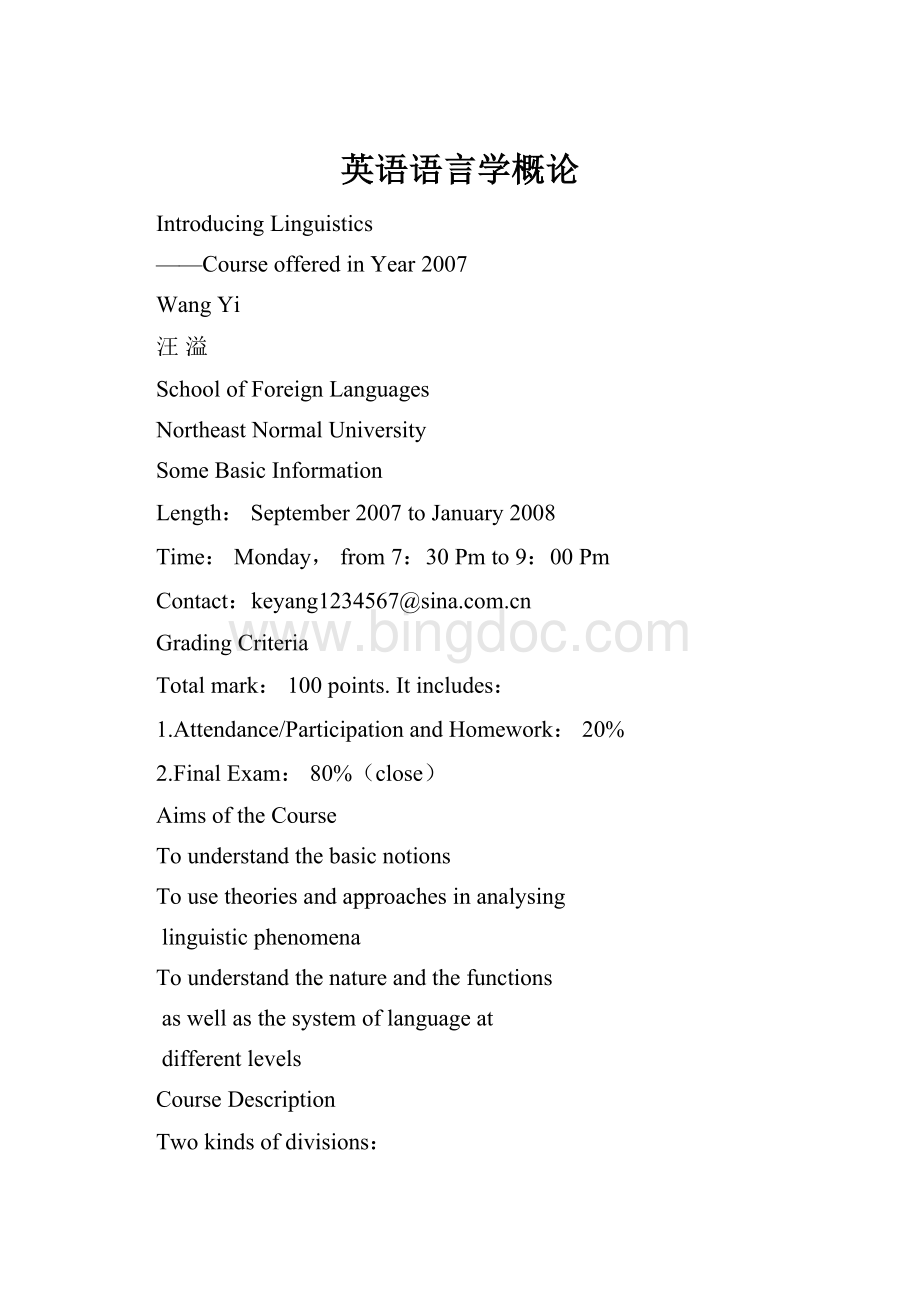英语语言学概论.docx
《英语语言学概论.docx》由会员分享,可在线阅读,更多相关《英语语言学概论.docx(31页珍藏版)》请在冰点文库上搜索。

英语语言学概论
IntroducingLinguistics
——CourseofferedinYear2007
WangYi
汪溢
SchoolofForeignLanguages
NortheastNormalUniversity
SomeBasicInformation
Length:
September2007toJanuary2008
Time:
Monday,from7:
30Pmto9:
00Pm
Contact:
keyang1234567@
GradingCriteria
Totalmark:
100points.Itincludes:
1.Attendance/ParticipationandHomework:
20%
2.FinalExam:
80%(close)
AimsoftheCourse
Tounderstandthebasicnotions
Tousetheoriesandapproachesinanalysing
linguisticphenomena
Tounderstandthenatureandthefunctions
aswellasthesystemoflanguageat
differentlevels
CourseDescription
Twokindsofdivisions:
1.Theintra-disciplinarydivisions
phonetics
phonology
morphology
syntax
semantics
pragmatics
CourseDescription
2.Theinter-disciplinarydivisions
languageinsocialcontexts
secondlanguageacquisition
linguisticsandforeignlanguageteaching
ReferenceBooks
课堂教材:
杨忠(主编),《语言学概论》IntroducingLinguistics,北京:
高等教育出版社,2002。
参考资料:
1.胡壮麟,刘润清,李延福(主编),《语言学教程》,北京:
北京大学出版社,1988。
2.胡壮麟(主编),《语言学教程》(修订版),北京:
北京大学出版社,2001。
3.戴炜栋,何兆熊,华钧(编著),《简明语言学教程》,上海:
上海外语教育出版社,1989。
ChapterOneLanguageand
Linguistics:
anOverview
1.Whatdoes‘language’mean?
*Generalsense
theuniversalpropertiesofallhumanlanguages,
i.e.thecommonfeatures,notjustone
particularlanguage.
Usedwithoutarticles.
*Specificsense
“inbad/dirtylanguage”:
“LuXun’slanguage”
“WangShuo’slanguage”:
“scientificlanguage”
“formallanguage”
“LSP”
“theChineselanguage”
“theEnglishlanguage”:
ElectronicLanguage
TextMessaging
1.RUOK?
2.YNY
3.OKCU2DAY?
4.NO2MORO
5.WER?
6.@J’S.CUL8TR
7.LUVB.
8.F2T?
9.N.WERRU?
10.@WK.NU?
11.@HM.CUL8TR?
12.Y.WEN?
13.OK.B4N.
ElectronicLanguage
TextMessaging
1.RUOK?
>AreyouOK?
2.YNU>Yesandyou?
3.OKCU2DAY?
>OK.Seeyoutoday?
4.NO2MORO>No.Tomorrow.
5.WER?
>Where
6.@J’S.CUL8TR>AtJohn’s.Seeyoulater.
7.LUVB.>LoveBob
8.F2T?
>Freetotalk?
9.N.WERRU?
>No.Whereareyou?
10.@WK.NU?
>Atwork.Andyou?
11.@HM.CUL8TR?
>Athome.Seeyoulater?
12.Y.WEN?
>Yes.When?
13.OK.B4N.>OK.Byefornow.
ElectronicLanguage
---F2T?
---Y
---WERRU?
---@HM.
---CU2DAY?
---NO2MORO
---WER?
---@J’S.CUL8TR
---OK.B4N.
Northeastlanguage
1、咋整的——怎么搞的。
2、稀罕——喜欢,爱。
我稀罕你,是说:
我爱你。
3、没咒念——没办法了。
4、嘛答——瞧不起人,用眼皮乜人。
你嘛答谁?
是说:
你瞧不起谁?
5、挠岗子了——跑了。
6、瘪茄子了——败了,没救了。
7、尿性——有本事,有能耐。
8、哪疙瘩——哪个地方。
9、激头白脸——发火,耍脾气的样子。
10、老鼻子啦——很多。
不着调——没正经的。
11、的色(dèsè)——不稳重。
12、糟尽了——浪费,可惜了。
13、吭哧瘪肚——说话不流畅,被称为是吭哧瘪肚的人
14、巴瞎——无根据的胡说。
2.Whatislanguage?
Manydefinitions:
Languageisatoolforhumancommunication.
Languageisasetofrulesbywhichsentencesareformed.
Languageisaninstrumentforexpressingthoughtsorforreasoning.
Agenerallyaccepteddefinition:
Languageisasystemofarbitrary
vocalsymbolsusedforhuman
communication.(Vardhaugh,1977).
Whatdoes“asystem”mean?
Example1:
Forthefollowingsounds
/s/,/t/,/i/,/l/,/p/
Possiblecombinations:
Impossiblecombinations:
Example2:
Forthefollowingwords
cat,dog,the,chased,the
Possiblecombinations:
Impossiblecombinations:
Thechasedcatthedog.
BUT:
Colourlessgreenideassleepfuriously.
The“symbolicnature”
oflanguage
Vocal?
Soundistheprimarymediumthroughwhichmeaningisconveyed.
Languagemaybeof
SpokenformWrittenform
√√
√╳
╳√
Human?
Onlyhumanbeingshavelanguagethatis
verydifferentfromthecommunication
systemsthatotheranimalshave.
Thearbitrarynatureoflanguage
ASummary
Languageisasystemofarbitrary
vocalsymbolsusedforhuman
communication.
Tosumup,theabovedefinitioncapturessomeimportantaspectsoflanguage.
Oralpractice
Partone:
sentencemaking
1.Mymother/fatheris(like)......,because......
2.WinterofChangchunis(like)......,because......
3.JakieChanis(like)......,because......
4.Computersare(like)......,because......
Parttwo:
chainstory
Itbeginslikethis:
Saraisagirl.......
3.Featuresofhumanlanguage
(also:
DesignFeatures)
thedefiningpropertiesofhumanlanguagewhicharedistinguishablefromthoseofthecommunicationsystemsofotheranimals.
3.Featuresofhumanlanguage
Creativity/Productivity
Duality
Arbitrariness
Displacement
Culturaltransmission
Interchangeability
Reflexivity
3.1Creativity/Productivity
Languageiscreative/productiveinthatuserscanproduceandunderstandwhattheyhaveneverspokenorheardbefore.
Orwemaysay,languageuserscancreateinfinitesentencesfollowingfiniterules.
e.g.‘Ared-eyedelephantisdancingonthe
hotelbed.’
Thefirstandforemostinimportanceandpeculiartohumanlanguage
Achild’slanguageacquisitioncanshowthisisso.
童言无忌
妞妞与嘟嘟的对话
妞妞:
你是新小朋友吗?
嘟嘟:
不是,我是旧小朋友。
^^……
问题:
有个老爷爷丢了一匹马,你认为马还会回来吗?
答:
那匹马肯定会回来的,因为它认识自己的脚印。
答:
我觉得马到外面去结婚了,不会回来了。
(好、好浪漫……)
答:
会回来的,因为它的押金还在老爷爷这里。
(好、好现实!
)
问题:
什么动物两只脚,早上太阳公公起来的时候,它会叫你起床?
小朋友A:
鸡,公鸡。
(另一个小孩叫道:
父鸡)
很好奇地问:
什么叫父鸡?
小朋友:
母鸡叫母鸡,公鸡就叫父鸡。
(恍然大悟……)
小朋友B:
妈妈。
小朋友C:
太阳。
(汗……太阳它是动物啊)
继续问:
太阳长脚吗?
小朋友C:
太阳有五只脚。
(另一个小孩反驳:
七只,彩虹是七种颜色的)
问题:
如果朝鱼塘里扔块石头,会发生什么现象?
小朋友A:
水会变成波波。
(……)
小朋友B:
鱼会漂上来。
(渔民很开心……)
小朋友C:
罚款五块。
(汗……)
千万别喝水
宝宝不小心,吞下一粒桔子核。
邻居小弟弟对他说:
“你千万别喝水,我哥哥说’种子得了水分和养料,就会发芽,生长’。
你要喝了水,头上就会长出桔子树来!
”
3.2Duality
3.3Arbitrariness
There’snologicalornatural,orinherent,relationbetweenthespeechsoundsandthemeaningstheyrepresent.Forexample,
3.4Displacement
notlimitedtotimeandspace
Question:
Isitpossiblethattwocatstalk
aboutthebone
theyfoundthe
daybefore
yesterday?
3.5CulturalTransmission
Languageisnotgeneticallypasseddowntosuccessive/followinggenerations.
culturallytransmitted
3.6Interchangeability
ahumanbeingcanbebothaproduceranda
receiverofmessages.
3.7Reflexivity
Humanlanguagescanbeusedtodescribethemselves.
Metalanguage:
thelanguageusedtotalkaboutlanguge.
AGrammaroftheDogLanguage
4.Functionsoflanguage:
Differentinterpretations
Thetraditionalinterpretation
Thefunctionalinterpretations
4.1Thetraditionalinterpretation
Examples:
Iwentthereyesterday.
Iwenttherelastmonth.
IwentthereimmediatelyafterIwasback.
4.2Thefunctionalinterpretations
Functionconcernswhatwedowithlanguage.
Whatfunctionscanweuselanguagetoperform?
4.2.1TheSpecificroles
(alsocalledspeechfunctions)
Thephaticfunction:
Thedirectivefunction:
Theinformativefunction:
Theinterrogativefunction:
Theexpressivefunction:
Theperformativefunction:
Thephaticfunction:
Socialcontactorrelations
Toestablish…Ormaintain…
Thedirectivefunction:
Togetthehearertodosomething
Theinformativefunction:
Totellwhatthespeakerbelieves,
Togiveinformationaboutfacts,or
Toreasonthingsout
Theinterrogativefunction:
Togetinformationfromothers
Theexpressivefunction
Torevealthefeelingsandattitudesof
thespeaker
Theperformativefunction:
Todothingsortoperformactions
4.2.2TheGeneralroles:
Themetafunctions
Theideationalfunction:
identify
Example1:
(Ifyouknowthereareonlytwochildrenin
thespeaker’s(Sam)family.)
Sam:
Ihaveabrother.
Example2:
Sam:
Ihavetwobrothers.(?
?
?
)
Theideationalfunction:
Toidentifythings,tothink,ortorecord
information.
Torepresenttheworldaroundus.
Asamediumthatlinksapersonwiththeworld.
Toconceptualizetheworld.
àThisfunctionoflanguagebringstheworld
intoourmind.
Theinterpersonalfunction:
Weuselanguageasamediumtogetalong
inacommunity.
Thisfunctionbindsindividualstogether.
Withthisfunctionlanguageisabletoglueallmembersofaspeechcommunity.
Thetextualfunction:
“香肠特价,一元五角一根;袜子十元四双。
”
5.Typesoflanguage
5.1Naturallanguagesvs.artificiallanguages
1)Naturallanguages:
Number
Differentstatus(officalvs.non-offical)
Linguafranca
2)Artificiallanguages(Esperanto)
5.2Thegeneticclassificationoflanguages
Assumption:
Languagesdiversifiedfromacommonancestor.
Languagefamilies:
e.g.Chinese:
Sino-TibetanFamily;English:
Indo-Europeanfamily,Latinisoneofitsbranch,anditincludsFrench,Italian,Spanish,Romanian,etc.
5.3Thetypologicalclassificationoflanguages
Itisbasedonacomparisonoftheformalsimilaritiesordifferencesbetweenlanguages.
Phonologically
Morphologically
Syntactically
Phonologically
speechsounds
Vowels
Consonants
Tone
e.g.Chinese/mǎ/andEnglish/hɔ:
s/
Morphologically
3types:
1.analyticlanguages分析型(Chinese,Vietnamese)
2.syntheticlanguages综合型(Latin,Greek.English)
3.agglutinatinglanguages黏着型(Turkish,Japanese)
examples:
1.胜,盛,国,周,水
2.Heisa____(boy)He___(work)hereeveryday.
Theyare____(boy)He___(work)herein1999.
Latin:
amo‘Ilove’
3.Japanese:
あなたはおうさんですか。
わたしはおういです。
わたしはおういではありません。
Turkish:
evlerimin(myhouse):
ev‘house’,-ler‘singular’,-im‘my’,-in‘genitive’
Morphologically
Tosumup:
Analytic/isolatinglanguages:
noinflectionsorformalchanges(ChineseandVietnamese)
Synthetic/inflectinglanguages:
changesoftheinternalstructureofwords,typicallytheinflectionalendings.(Latin,GreekandArabic)
Agglutinatinglanguages:
wordsbeingbuiltoutofalongsequenceofunits
InSyntax
Wordorder
Mostfrequentwordorders:
Concludingremarks
Languagesarediversified;
Theyarealsoremarkablysimilarinmanyways.
Thesimilaritiesprovideessentialdataforthestudyoftheuniversalityoflanguage.
6.Languageorigin
6.Languageorigin
Scientificinterpretations:
humaninvention
TheBow-wowtheory:
imitationofnaturalsound
ThePooh-poohtheory